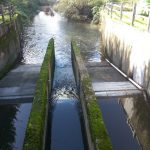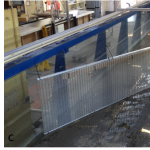The development of effective fish passage and screening strategies have become increasingly important in the face of the challenges of developing environmentally sustainable energy (e.g. hydropower, traditional coal and gas, new generation nuclear power, and marine and coastal renewable technology) and water resource infrastructure (e.g. impoundments and culverts). At ICER, current paradigms related to fish passage and screening strategies are re-evaluated by taking fish behaviour and ecology into account. An interdisciplinary team of scientists (including fish biologists and hydraulic engineers) employ techniques, ranging from controlled laboratory and open channel flume trials to field based telemetry studies, ensuring fish passage issues are explored across a broad range of spatial and temporal scales.
Upstream Passage
| Coarse fish passage at
gauging weirs
|
Eel and lamprey passage
at gauging weirs |
| Eel and lamprey passage
through culverts
|
Eel and lamprey passage
through culverts |
|
Developing fish passage criteria for Chinese fish |
Downstream Passage
| Tide gate modifications for
eel and sea trout |
Tracking downstream
movement of eel |
| Screening intakes for juvenile
lamprey |
Screening intakes for juvenile
coarse fish |









